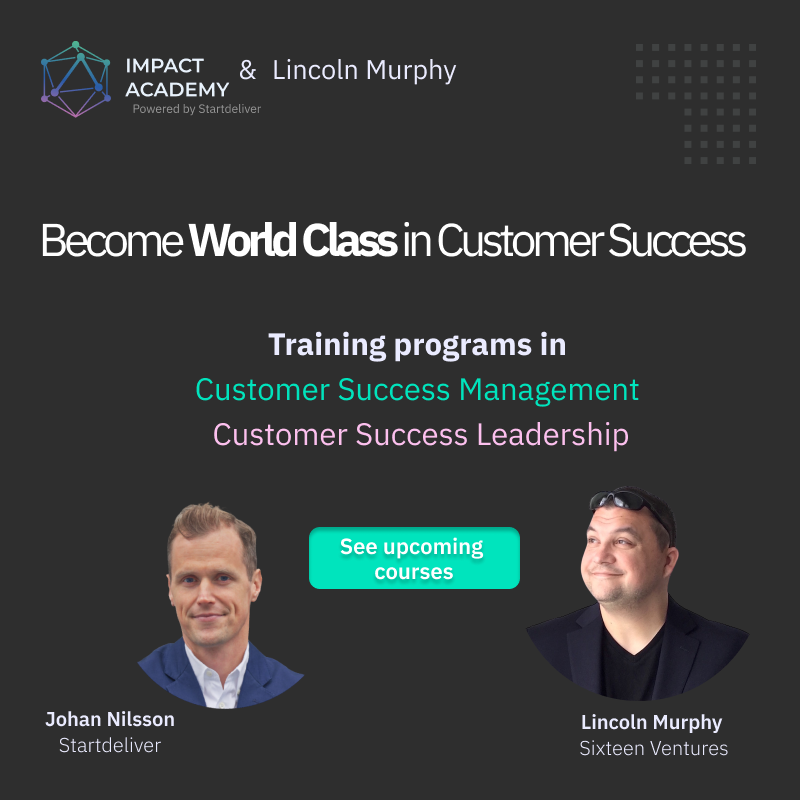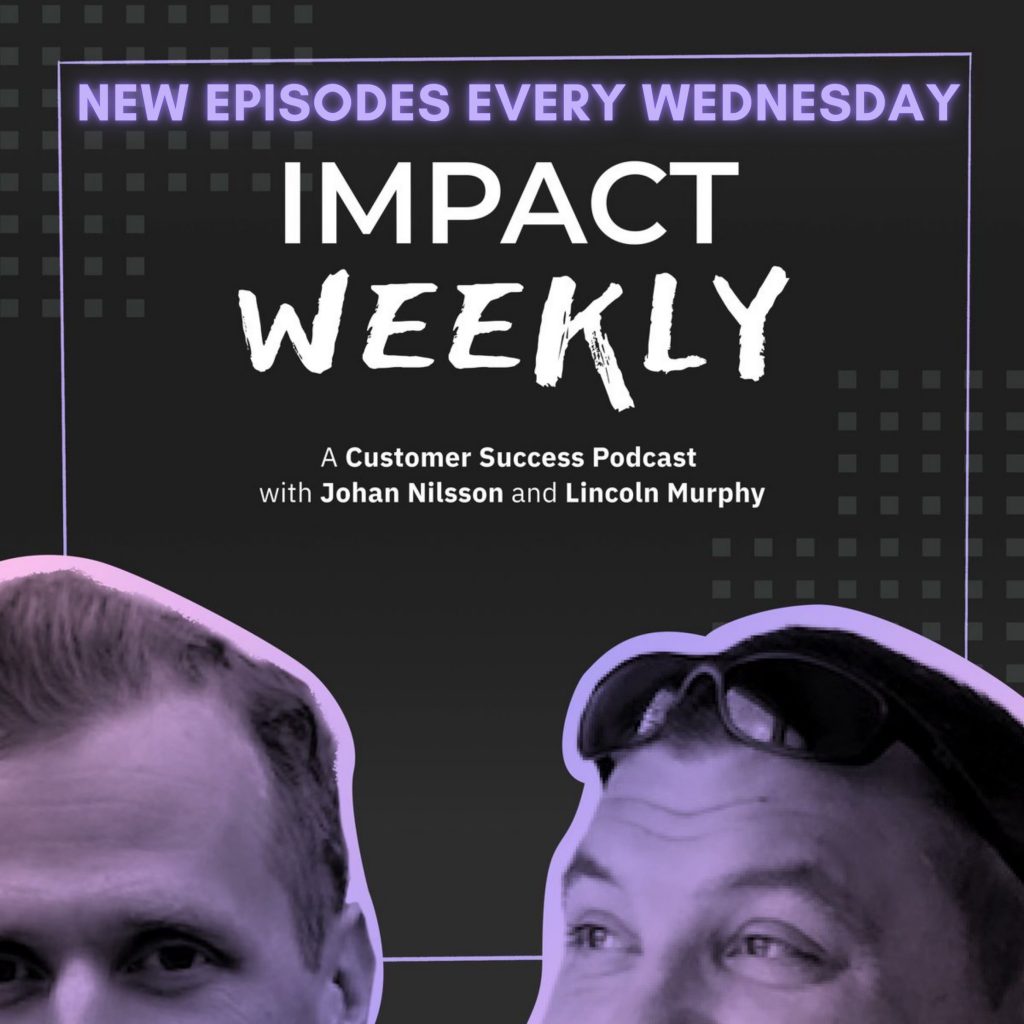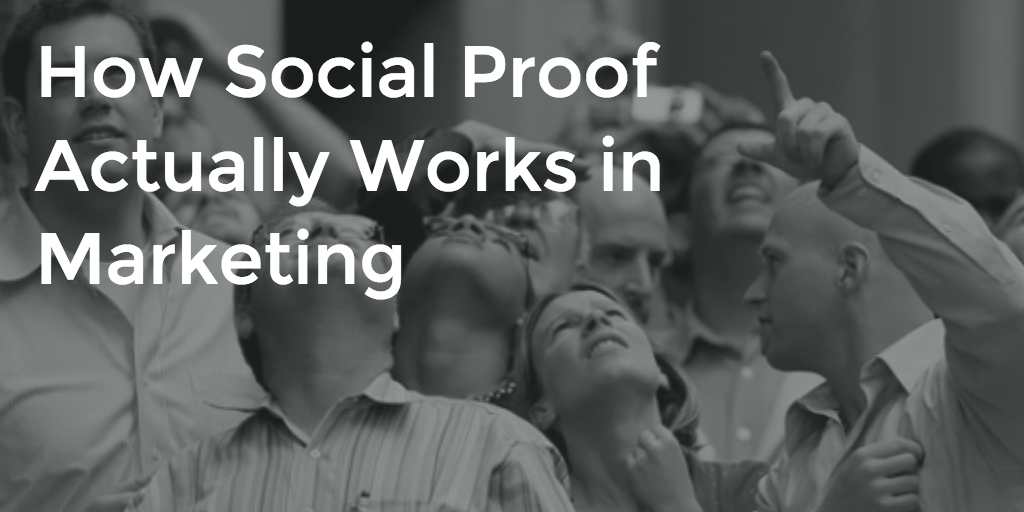 I’m not a psychologist, but I play one every day as I try to figure out why people (users, customers, visitors, etc.) do what they do… and how to get them to do more of what I want them to do.
I’m not a psychologist, but I play one every day as I try to figure out why people (users, customers, visitors, etc.) do what they do… and how to get them to do more of what I want them to do.
I spend a lot more time reading books about – and otherwise studying – human psychology and the way our brains operate, than I do on specific marketing techniques, growth hacks, or the latest viral sensation.
Those things are fleeting, but the way our brain works is much slower to change.
One of the people I’ve learned the most from when it comes to human behavior is Dr. Robert Cialdini, starting with his game changing book Influence. He and others from his Influence at Work group have released other books that provided real-world examples of how to leverage the principles of Influence – or avoid them – but Influence is still my go-to resource.
Dr. Cialdini has posited that there are six principles of persuasion – Reciprocation, Liking, Consensus, Authority, Consistency, and Scarcity – each of which has the power to elicit certain behaviors (simply due to how our brains work) in those at whom the principle is focused.
In this article I want to explore the Principle of Consensus, otherwise known in marketing as “Social Proof” and in Customer Success as “Advocacy.”
Generally when we think of Social Proof we think of…
- A person wearing nice clothes crossing the street against the light, so you follow her (she must know what she’s doing… she’s dressed so professionally).
- A group of people looking up in the sky… so you look up, too.
- 9 out of 10 Dentists prefer…
- The number of Retweets, Likes, or Repins a piece of content gets on the various social networks.
- The number of backers on Kickstarter
- This many other readers highlighted this section in a Kindle ebook
- A hit counter on your web page (for those of you joining us from 1996)
But when we’re marketing B2B SaaS and software products, the proof isn’t in the pudding (or any of those things on the list above), it’s with others who have used – or can vouch for – your product.
Social Proof and The Principle of Consensus
That sounds like a fantasy genre book title.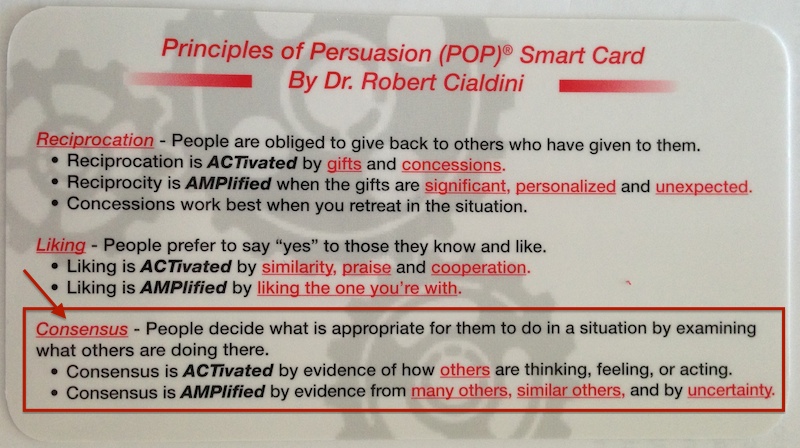
Anyway, according to my wallet-sized Principles of Persuasion card I got when I spent some time with the Influence at Work group in Phoenix a while back (that I carry with me everyday because I’m just that awesome), Consensus is when “people decide what is appropriate for them to do in a situation by examining what others are doing.”
The card goes on to say that Consensus is ACTIVATED by evidence of how others are thinking, feeling, or acting.
It also says that Consensus is AMPLIFIED by evidence from many others, similar others, and by uncertainty.
Every Principle of Persuasion has Amplifiers; things that, when they happen, markedly improve the effectiveness of the principle, but let’s talk specifically about…
Social Proof Amplifiers
Of the three amplifiers of Consensus, similarity and uncertainty are the most interesting in the world of B2B SaaS, especially for niche or vertical-focused products.
I’ll discuss similarity in a lot more detail later, so for now I want to touch on uncertainty; such a simple, but incredibly powerful concept.
When we don’t know what to do, we look to others for cues (or sometimes exactly what we should do).
When we don’t know what to do it’s usually for one of two reasons: there are no obvious choices or too many.
We’re either starting from scratch or are overwhelmed by options.
So we look to others to help move us forward.
Looking to others when we don’t know what to do is human nature.
Social Proof – the Principle of Consensus – simply leverages (takes advantage of) that human nature.
If you’re entering a crowded market with your SaaS product, one way to cut through the clutter is to heavily leverage Social Proof.
If you’re creating a new product category (like we did at Gainsight by literally creating the Customer Success Management software product category), you’ll probably need to leverage all three types of Social Proof below at various stages of your evolution.
Understanding Consensus and what activates it – what triggers our brains to react a certain way – and what amplifies this principle, are absolutely critical when it comes to putting these concepts to work.
That’s why I wanted to examine this idea of Consensus as it relates to Social Proof as a marketing technique.
That starts by understanding that there are…
Three types of Social Proof
You can probably get more granular and come up with other types, but in my experience, when it comes to Social Proof there are basically three kinds: Similar, Aspirational, and Endorsement.
Knowing the difference will help you get the results you’re looking for in your marketing.
On the flip side, NOT knowing the difference could literally derail your marketing efforts, so it pays to know what you’re doing.
Let’s look at each type in more detail.
1. Similar Social Proof
Social Proof that’s “similar” is when you display the logos of – or testimonials from – customers that are the same as your Ideal Customer.
This is the most basic type of Social Proof and is generally what we think of when we hear “social proof” from a marketing standpoint.
When we display logos of our customers on our marketing websites, if we think about what we’re trying to do at all, it generally falls into the “similar” category, right?
“I’ll put these logos on my site and hope that others like them will contact me or sign-up for our service” you say to yourself.
So you put all the logos on your site without really thinking through the ramifications of that. In fact, you’re quick to add the logo of that giant company you landed because, well, how cool is that, right?
Well, it might not be that cool if your Ideal Customer isn’t like that giant company and thinks, based on the presence of that logo, that your solution – even if it’s right for them – is likely too far out of reach. “If Walmart can afford it, we can’t.”
It is tempting to show off that giant logo you landed, but if that’s incongruent with your Ideal Customer Profile you may scare them away.
When it comes to Social Proof, defining your Ideal Customer Profile is critical so you can leverage Social Proof that’s similar to the customers you really want to land; outliers (and ego-boosters) be damned.
A Quick Note on Viral Expansion
If you’re thinking about your viral expansion opportunities – both intra and inter-company virality – for your product, remember that you’ll be taking advantage of the principles of Social Proof there, too.
Awesome, right? Sure… but just know that virality is almost always horizontal, which means you shouldn’t assume advocacy programs and viral loops will help you land better (more ideal) customers than you already have. It just doesn’t tend to work that way in reality.
If you have less-than-ideal customers advocating for you or otherwise spreading the word, they’ll bring in more like them.
Yet another reason to focus on your Ideal Customer in the first place.
Okay, all of that said, there IS a time and place for displaying logos of companies larger (or more successful) than your Ideal Customers and that’s called…
2. Aspirational Social Proof
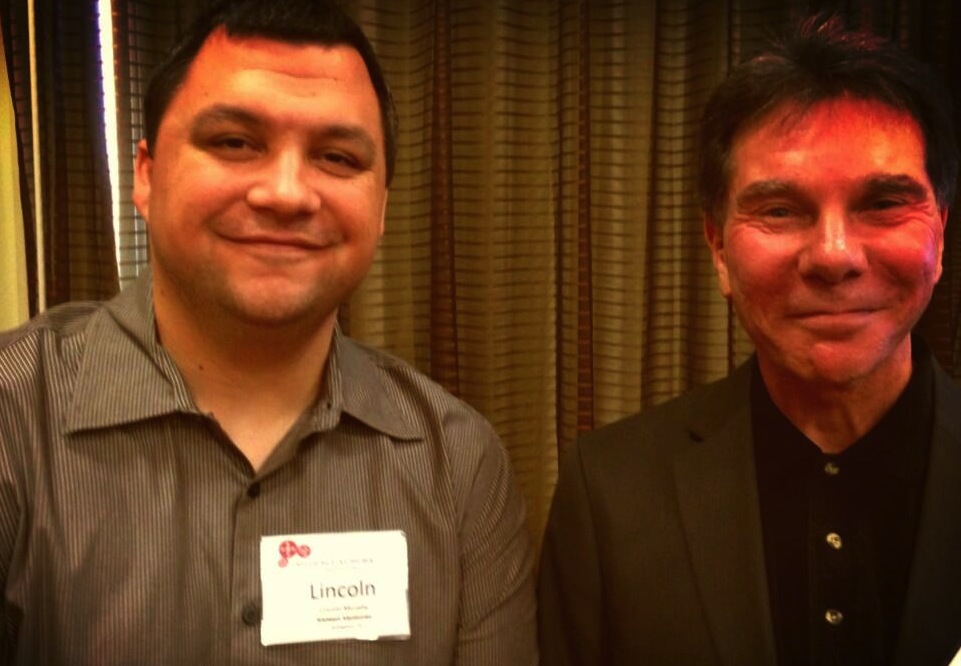
Lincoln Murphy and Dr. Robert Cialdini in Phoenix, Arizona
Social Proof that’s “aspirational” is when you display reviews, video testimonials, or logos of companies that your Ideal Customer prospects want to be like.
But let me be clear; aspirational social proof is potentially dangerous as your ideal customers may not get it & think bigger customers mean you’re out of their price range.
This is yet another reason to really get to know your Ideal Customer, understand their Desired Outcome, and then use that knowledge to engage these psychological principles.
If you sell to B2B startups that are post-series A funding, for example, the leaders of those organizations may have aspirations of being $100M (and eventually $1B Unicorns) companies and want to operate as such. They may not need a world-class subscription management platform like Zuora or a world-class Customer Success Management product like Gainsight today, but if they want to be a $100M company, they should act like one.
Knowing that this is your Ideal Customer, you’d show them the logos (and other Social Proof elements) from the companies they want to be like someday… not the companies they’re like today.
But you have to know your Ideal Customer or this could have the opposite effect.
Okay, so what if you’re just starting out and don’t have any “Similar” or “Aspirational” Social Proof to offer? You can use…
3. Endorsements (Celebrity or Otherwise)
Endorsements are just that… someone that your Ideal Customer trusts, advocating for your product.
When you don’t have customers yet – or don’t have customers that have achieved the necessary success milestones that would make being an advocate for you a logical next step – you may have to go a different route.
Finding someone that you can show the product to, who can see the real value (potential) in it, and is willing to share their perception of the product (sometimes for a what amounts to a fee) with your potential customers can go a long way.
You might have to give them or their customers access to your product at no charge in order for them to see the value in your product, but it’s probably worth it at first.
Or you might have to “sponsor” research that – fingers crossed and breath held – comes out in your favor so you can distribute the research to your prospects. Trusted analysts can “endorse” you without actually endorsing you. What a world.
And of course there’s the celebrity endorsement route… think about what happens when Tim Ferris or Oprah mention a product. But that “celebrity” has to be someone that jibes with your Ideal Customer, otherwise it really won’t have the desired effect.
Kim Kardashian shilling for your project management app may not give you the result you want.
Snoop Dogg on the other hand…
